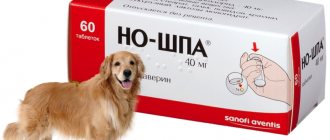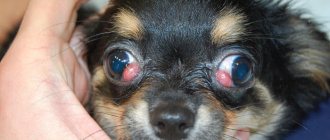Epilepsy in dogs is a common, chronic neurological disorder that causes the animal to experience sudden, uncontrollable, repeated seizures. Epileptic seizures (fits) can occur with or without loss of consciousness. The first seizure can frighten an owner who has never seen seizures in dogs. Don't be afraid - this is not a death sentence! But there is no need to relax - the disease must be diagnosed and treated in time. From our material you will learn why there is no need to be afraid of seizures, what the owner should know about epilepsy. Learn how to stop seizures and help your pet. This knowledge will help you react correctly to your pet’s condition and provide your dog with competent assistance in a timely manner.
First aid
The most important thing an owner can do for his dog is to remain calm and sober. This is the first and main point in our memo. During an attack, a dog has absolutely no control over itself and its behavior; it can injure itself. The owner must be nearby to protect the pet from possible bruises and injuries.
Reminder - what to do during a seizure
- The most important thing is to remain calm and not touch your pet during a seizure. Some owners try to move the animal, they want to put it in a safe place. This is mistake! When the seizure begins, leave the dog in the place where the seizure occurred .
- The only case when you can shift the dog is if the seizure overtook him on a high staircase. The risk of falling must be eliminated.
- Move furniture and other furnishings that your pet could hit. Your task is to ensure that the dog does not injure itself.
- Create silence and darkness in the room where the sick animal is located. There is no need for the whole family to crowd around the pet.
- Provide fresh air into the room. Open the vents, windows, doors.
- There is no need to try to calm your pet with words and gestures - this can provoke an increase in neurotic reaction.
- Do not touch or hold the dog . The only thing you can do is gently turn her head to the side.
- Do not try to open your jaw with your hands or objects . An animal may bite you. To prevent the tongue from sticking, the animal must be on a flat floor with its head turned to one side.
- To help your veterinarian make a diagnosis, time the start and end of the seizure. It will be very good if you manage to film the attack on video and keep a special diary for recording seizures.
- When the seizures end, contact your veterinarian, tell him about the symptoms, duration of the seizures. If the seizure lasted for a long time (more than 5 minutes), invite a doctor to your home.
Important!
Forget the common advice of inserting a spoon between the animal's teeth to open the jaws. This is a wrong recommendation. This can injure the dog.
Classification of epilepsy
Epilepsy in dogs is divided into structural (acquired) and idiopathic (congenital).
Structural (secondary) epilepsy
The root cause of this type of epilepsy is some kind of brain pathology. Seizures occur against the background of abnormalities in brain development, injuries, infectious pathologies, and neoplasms in the brain.
Idiopathic epilepsy
This is the most common type of epilepsy in dogs. This diagnosis is made if the underlying cause of the seizures cannot be identified. The disease usually affects young animals from six months to 6 years.
It is generally accepted that idiopathic epilepsy occurs as a result of a combination of genetic predisposition and negative external factors. The disease is lifelong; the dog requires lifelong observation and supportive therapy.
Diagnosing epilepsy in dogs
If cases similar to neurological problems have been noticed, you should immediately contact a veterinary hospital, be examined and make a diagnosis. The owner needs to clearly describe the symptoms and behavioral characteristics.
The disease cannot be completely eliminated, but the use of therapeutic drugs will help maintain a comfortable standard of living for the patient, prolong life and prevent relapses.
It is important for every owner to remember that in case of canine epileptic seizures, indefinite drug treatment is prescribed. Medicines are prescribed exclusively by a veterinarian, who also warns about possible side effects.
Diagnostic methods used for suspected epilepsy in dogs:
- electroencephalography (EEG), which determines the frequency of electronic impulses in the animal's head;
- X-ray of the skull to find out information about the presence of injuries, blood clots, neoplasms;
- Magnetic resonance imaging (MRI) of the head, which reveals disorders of the nervous system, disturbances in the blood supply, tumors or inflammation.
Only a specialist in a veterinary clinic can make an accurate diagnosis and prescribe further treatment for a patient. No advice given in absentia or recommendations over the phone can give an objective picture of a neurological disorder.
Causes
Epileptic seizures occur for a number of reasons. Some of them are hereditary, some are acquired.
Congenital causes
- Degenerative pathologies of the brain.
- Head injuries received at birth.
- Infectious diseases during a dog's pregnancy can cause epilepsy in puppies.
- Unfair breeding of purebred animals with defective genes and closely related individuals.
All congenital causes can only be identified after in-depth diagnostic studies.
Acquired reasons
- Traumatic brain injuries sustained in childhood and adulthood.
- Neoplasms of benign and malignant nature in the brain.
- Viral and bacterial infections.
- Toxic effects of lead, mercury, arsenic and other toxic substances.
- Hormonal imbalance due to endocrine pathologies.
- Exhaustion due to prolonged fasting or poor diet.
- Severe fear, stressful situations.
- Serious pathologies of internal organs and systems: urolithiasis, heart failure, kidney and liver pathologies.
- Infection with helminths.
- Poisonous snake bites.
- Electric shock.
- Deficiency of vitamins and minerals necessary for the functioning of the nervous system: magnesium, calcium, B vitamins, vitamin D.
Important!
The causes of acquired epilepsy are often identified too late. Since several years may pass between an attack of epilepsy and the cause that caused it.
Dog Breeds Prone to Epilepsy
Idiopathic epilepsy is a genetic disorder in some dog breeds. Dogs of these breeds should be tested for epilepsy and not allowed to breed if pathology is detected.
Breeds in which epilepsy is most often detected:
- beagle;
- Golden retriever;
- Labrador Retriever;
- Belgian Shepherd Tervuren;
- dachshund;
- collie;
- Sheltie;
- Irish Setter;
- Bernese Mountain Dog;
- Finnish Spitz;
- Irish Wolfhound;
- Hungarian Vizsla;
- Keeshond;
- miniature schnauzer;
- English Springer Spaniel.
Causes of epilepsy
What is epilepsy in dogs and why does it occur? Epilepsy refers to neurological disorders that occur directly within the brain.
It is believed that during an attack, brain cells lose their electrical stability. As a result, this causes a strong electrical discharge, affecting all tissues and leading to disruption of their normal functioning.
Signs of epilepsy in dogs are hard to miss. If the owner of the animal is in doubt, then on the Internet you can find many videos with the approximate title “epilepsy in dogs video.” During an attack, the dog begins to have seizures and convulsions. Depending on the severity of the attack, this can range from mild twitching to serious impairment of motor functions, which can lead to serious consequences.
Canine epilepsy can be congenital (primary) or acquired (secondary).
The primary form of epilepsy occurs solely due to a genetic predisposition or in the presence of natural neurological abnormalities in the functioning of the brain. Diagnosed congenital epilepsy, unfortunately, cannot be treated. In this case, the dog can only be made easier by undergoing a periodic course of treatment.
Any dog can be born with a similar nervous system disorder. True, some breeds have a greater predisposition to this, for example: hounds, most shepherd dogs, cocker spaniels, Irish setters, schnauzers, St. Bernards, terriers, etc. Epilepsy in dogs is diagnosed at approximately six months of age.
However, if such a diagnosis is made, this does not mean that the animal will not be able to live a full life. Moreover, it is far from a fact that her offspring will also develop this disease. Although it is better not to use such individuals for breeding.
There can be many reasons for the appearance of the secondary form of the disease.
Epilepsy in puppies and young dogs (up to one year old) can occur as a result of the influence of the following factors:
- infectious diseases (encephalitis, plague, etc.);
- intoxication;
- presence of head injuries;
- blood sugar levels are too high or low;
- intestinal parasites;
- constant stress;
- severe emotional shock.
In adulthood (over 5 years), age-related diseases may be added to the above factors:
- disorders of the liver or kidneys;
- arrhythmia and other cardiovascular diseases.
It follows that almost any dog can get this disorder. Epilepsy is not particularly selective in this regard.
Treatment
Idiopathic (true) epilepsy cannot be treated. Only the root cause that caused the pathology can be cured.
Therapy in the case of epilepsy consists of anticonvulsant treatment, which is aimed at stopping seizures, reducing their frequency, and achieving long-term remission. The task of the owner and veterinarian is to improve the quality of life of a sick animal. With timely administration of antiepileptic drugs, long-term remission is achieved in 15-30% of dogs.
Dogs with idiopathic epilepsy who experience 1 to 2 seizures per year are not prescribed treatment.
When does a dog need medication?
Drug treatment is prescribed by a veterinarian based on diagnostic studies and analysis of the nature of the attacks based on the diary kept by the owner.
Therapy is prescribed in the following cases:
- the animal has more than 1 seizure per month;
- the duration of each attack is more than 5 minutes;
- convulsive seizures are repeated one after another after a short period of time;
- the severity of the seizures increases, the dog’s condition worsens.
Such animals are prescribed lifelong treatment under constant veterinary supervision. To select the correct dosage and monitor the pet’s condition, the doctor must check the pet’s health and do a blood test.
Important!
Do not neglect regular preventive examinations in order to promptly identify possible negative consequences of antiepileptic therapy or epilepsy attacks.
Medications
The list of veterinary drugs used in the treatment of epilepsy is insignificant - this is due to their high toxicity.
Domestic and foreign veterinarians use the following medications in antiepileptic therapy for dogs:
Phenobarbital
An effective anticonvulsant and sedative that has been used for a long time. Reduces the dog's excitability, increases resistance to stressful situations, and prevents epileptic seizures. Available in the form of injections, tablets and syrup. The medicine is dispensed from the pharmacy with a prescription. Strict adherence to the dosage prescribed by the veterinarian is required.
Recommended starting dose: 2.5-3 mg/kg 2 times a day.
Contraindications : chronic liver diseases.
Side effects:
- sedation (drowsiness);
- polyphagia (gluttony);
- partial or complete loss of coordination of movements (ataxia);
- thirst and increased urination.
Imepitoin
The new generation drug has been used in veterinary practice since 2013. Recommended for identifying idiopathic epilepsy. Has fewer side effects. Available in tablets.
Recommended initial dose: 10-20 mg/kg 2 times a day.
Contraindications : weight below 5 kg.
Side effect : gluttony (polyphagia).
Potassium bromide (KBr)
It is used in veterinary medicine only as an adjuvant in complex therapy with anticonvulsants. Improves control of seizures. It has many side effects and must be taken under constant veterinary supervision.
Recommended dosage: 15 mg/kg 2 times a day.
Contraindications : kidney and liver pathologies.
Side effects:
- drowsiness;
- voracity;
- loss of coordination of movements;
- hind limb weakness;
- vomiting and nausea.
The first two drugs are first-line drugs. The veterinarian may prescribe your dog either Phenobarbital or Impetion, a new generation anticonvulsant drug.
Potassium bromide is prescribed additionally if therapy with first-line drugs does not produce the desired effect. Combination use of drugs is possible. The type of drugs and their combination, as well as the dosage, is chosen by the attending veterinarian. Self-medication is unacceptable for this serious pathology.
Important!
Never give dogs epilepsy medications from a human medicine cabinet.
Diet for epilepsy
Proper diet plays an important role in the prevention and treatment of dogs with epilepsy . Your veterinarian may be able to create a new diet for your sick dog to help control seizures.
- The main rule is to be consistent. Frequent changes in food can trigger attacks.
- Follow feeding standards - do not overfeed, and do not keep your pet on a starvation diet.
- Give meals at the same time, stick to the schedule.
- Do not give your dog hot or cold food - only warm food is allowed.
- Include in the diet of dogs on a natural diet: sardines, legumes, white cabbage, boiled carrots and millet. The amount of animal proteins needs to be reduced. Avoid salty foods.
- Ready-made feeds should contain sufficient amounts of magnesium, B vitamins and manganese.
- Naturally fed pets must be given vitamin and mineral complexes as prescribed by a veterinarian.
Alternative Treatments
Traditional medicine is not used for epilepsy. Only vitamin therapy and acupuncture are allowed for dogs. Acupuncture is carried out on 10 sensitive points, in sessions of 20 minutes. within 30 days. Vitamin therapy is aimed mainly at replenishing the deficiency of B vitamins.
Important!
These methods do not replace traditional medicine; they are prescribed as part of complex therapy along with anticonvulsants.
Status epilepticus (SE)
What is it? It can often be interpreted as "epistatus". This is a condition in which seizures last long enough and/or are repeated often enough to create a permanent and prolonged epileptic state. The generally accepted definition in veterinary medicine is a seizure that lasts more than 5 minutes, or two (or more) consecutive seizures without full recovery of consciousness.
Causes
Epileptic seizures can be caused by any process that alters the normal function of neurons in the brain. The most likely diseases should be considered taking into account breed, sex, age, clinical and neurological examination results, as well as additional diagnostics.
Idiopathic epilepsy.
In this case, upon detailed examination and clarification of the causes of brain pathologies, no pathologies are detected. The cause may be genetic (primary) or unknown (actually idiopathic). When making such a diagnosis, the most important thing is the absence of neurological disorders during examination; in the interval between seizures, the animal appears normal. Also, diagnostic studies do not show systemic abnormalities of brain disorders. Clinically, the diagnosis of idiopathic epilepsy is made by exclusion.
Symptomatic epilepsy
It is explained by the fact that it can occur when there is a deficiency of a key enzyme and can cause disruption of metabolic pathways and the accumulation of metabolic by-products in neurons.
Inflammatory or infectious diseases
Any inflammatory or infectious disease that affects the brain has the potential to cause seizures.
The most common infectious disease in dogs is canine distemper. Seizures may develop in the absence of any noticeable clinical signs of the disease or long after the clinical form of the disease has resolved. The most common inflammatory non-infectious disease in dogs is granulomatous meningoencephalomyelitis (GME). The diagnosis of an inflammatory or non-infectious disease of the central nervous system requires MRI and CT, as well as laboratory tests and serological tests.
Neoplasms
Neoplasms in the cranial cavity, primary or secondary, can cause seizures. Convulsive activity depends on the extent of damage to neurons adjacent to the tumor due to compression or displacement, as well as insufficient blood supply. Sometimes seizures are the first symptom of a brain tumor.
Neurological abnormalities may not appear until several weeks or months after the onset of seizures, especially if the tumor is located in the rastral (located closer to the head or the front end of the body) part of the cerebrum. The preferred research method is MRI diagnostics.
Seizures associated with eating disorders
Seizures in animals can occur with the manifestation of a number of nutritional disorders. Most often they are caused by a lack of B vitamins.
Intoxication
Many poisons affect the central nervous system and can cause convulsions. Toxins provoke seizures through various mechanisms: increased excitation, decreased inhibition. The most important thing in such situations is to know what could cause such intoxication and to identify the toxic substance.
What should the owner of a sick animal do?
- The tablets should be given at the same time every day.
- It is important to follow the prescribed dosage.
- It is unacceptable to interrupt or stop treatment without a veterinarian's prescription.
- Do not resort to traditional methods of treatment. They are not effective for epilepsy.
- Keep a diary in which you note all epileptic seizures and describe their duration and symptoms.
- Visit the clinic every 3 months to have blood drawn and see a neurologist.
Important!
Long-term use of antiepileptic drugs can lead to the development of anemia in the dog. Get your blood tested regularly.
How to know if treatment is helping
Antiepileptic therapy is considered successful if seizures stop completely or their number is reduced by half. If a 50% reduction in the frequency of attacks cannot be achieved, the doctor may prescribe additional medications or increase the dosage of monotherapy.
How to detect epilepsy attacks
To evaluate the effectiveness of treatment, it is important to keep a diary and note all recorded cases in it. For the convenience of owners of dogs with epilepsy, an application for smartphones, RVC Pet Epilepsy Tracker, has been developed, in which seizures can be noted and described in detail.
You can also use the PetPace smart collar, which can detect seizures when your dog is home alone. The collar records all indicators (pulse, temperature, breathing rate) and can send the owner a message on a smartphone when a seizure is approaching.
How long do dogs with epilepsy live?
It all depends on what type of epilepsy and when the dog was diagnosed. With timely diagnosis and lifelong therapy, dogs can live to a ripe old age.
Life expectancy is affected by:
- the age of the dog at which the first seizures appeared;
- severity of epileptic seizures and their frequency;
- the dog’s reaction to therapy, the presence of side effects;
- type of epilepsy and cause of seizures;
- whether the animal receives or does not receive treatment.
Symptoms
The dog owner needs to be able to diagnose an approaching seizure in order to have time to provide help to the pet. To do this, you need to know the symptoms of the pathology. An epileptic seizure occurs in several stages (phases), each stage has its own symptoms.
- Prodromal (early) . This period passes without significant symptoms. Duration: from several days to 2-3 hours. The animal may be worried and show increased anxiety.
- Aura (preliminary phase) . Lasts from 1 to 30 minutes. The dog shows anxiety, whines, trembles, and drools. There may be a slight loss of coordination. Sometimes the aura manifests itself as complete immobility of the animal.
- Seizure (ictal phase) . Direct epileptic seizure. Manifested by muscle cramps and arching of the body. The dog may fall, lose consciousness, suffer from hallucinations, and jerk its legs randomly. The head is thrown back. The body becomes partially numb. Increased salivation, chattering of teeth and chewing appear. Involuntary emptying of the bladder and bowels is possible. Lasts from a few seconds to 5 minutes.
- Postictal phase (recovery period) . The animal is lethargic, disoriented, with confused consciousness. The dog does not recognize the owner, gets scared, and may be overly restless. The period of recovery from a seizure can last from several hours to 3 days.
In each specific case the picture may be different. It is important to note all this in your observation diary.
Pexion 400 mg drug for the treatment of epilepsy in dogs 100 tablets (Vetapteka)
Action
Imepitoin (1,4-chlorophenyl-4-morpholino-imidazol-2-one) included in the composition belongs to a compound of the group of antiepileptic (anticonvulsant) substances of central action, which penetrates the blood-brain barrier without being involved in active transport or active excretion, which leads to rapid achievement of equilibrium of its concentration in plasma and brain cells.
Imepitoin inhibits seizures through potentiation of GABAa receptor-transmitter effects on neurons. In addition, it has low potency in blocking calcium channels, which may contribute to the drug's anticonvulsant properties.
Imepitoin has a weak anxiolytic (suppressing fear, anxiety) effect.
A decrease or absence of the antiepileptic effect was not observed with prolonged treatment with Pexiosh for 6 months.
Absorption
Pharmacokinetic studies indicate that imepitoin is well (>92%) absorbed after oral administration, thereby achieving a rapid initial effect. After oral administration of imepitoin tablets at a rate of 30 mg/kg on an empty stomach, the peak of its concentration in the blood quickly reaches a maximum after approximately 2 hours (Tmax) to a value of 18 mcg/ml (Cmax) - The use of imepitoin tablets with food reduces the concentration in the blood by 30%, but does not lead to a significant change in Tmax and Stach. No particular gender differences were identified.
Distribution
Linearity appears over the therapeutic dose range of impetoin.
Imepitoin has a relatively high volume of distribution (579 to 1548 ml/kg). The binding of impetoin to plasma proteins in vivo is only 60-70%. Accumulation of imepitoin in plasma does not occur after reaching a stable concentration.
Metabolism
Imepitoin is actively metabolized before elimination. Four major inactive metabolites, which are formed by oxidative modification, have been identified in urine and feces.
Selection
Imepitoin is rapidly cleared from the blood (260 to 568 ml/hour/kg) with a half-life of approximately 1.5 to 2 hours. The majority of impetoin and its metabolites are excreted through feces rather than urine, so large variations in pharmacokinetics and drug accumulation should not be expected in dogs with genitourinary dysfunction.
In terms of the degree of impact on the body, Pexion is classified as a moderately hazardous substance (hazard class 3 according to GOST 12.1.007-76).
Diagnostics
To make a correct diagnosis, it is important to carefully study the history. Your diary entries and descriptions of the attacks will help the doctor with this. A veterinary neurologist makes a diagnosis based on an assessment of the age of onset of epilepsy and the frequency and duration of seizures. In addition, the clinic conducts a number of diagnostic studies.
Diagnostic methods
- Collection and study of anamnesis.
- Primary visual examination, palpation.
- General urine analysis
- General and biochemical blood test.
- Determination of residual nitrogen in urea.
- Ultrasound of the abdominal organs.
- Radiography.
- CT scan.
- Fecal analysis for helminths.
- Measuring blood glucose levels.
- Electroencephalogram.
- Cerebrospinal fluid analysis.
- Measurement of lead and calcium concentrations in biological fluids.
- Cardiogram.
When diagnosing epilepsy and identifying genetic predisposition, special attention is paid to studying the dog’s pedigree. The final diagnosis is made only after studying and summarizing all the tests.
Treatment and diagnosis
It is important and necessary to conduct an examination of an epileptic dog; the treatment process will be based on what caused the disease and what ailments accompany it. It is important to exclude pathologies with similar manifestations.
Research methods:
- EEG. An electroencephalogram is necessary; this is the most informative way to make a diagnosis of epilepsy;
- X-ray (to rule out traumatic brain injury);
- Ultrasound of the abdominal cavity;
- CT, MRI of the head;
- ECG.
Biochemical and clinical blood tests are used as general laboratory methods.
The owner must describe as accurately as possible how the attack occurs, the dog’s behavior, the prerequisites for it (injuries, stress, etc.). Anamnesis (collection of information) will help make the correct diagnosis.
Important factors: the age at which the first symptoms of epilepsy appeared, the frequency of attacks, their duration and form. Most likely, the diagnosis of “idiopathic epilepsy” will not be considered if seizures occurred more than 2 times a week after the first episode of the disease.
At the age of 6 months to 5-6 years, epilepsy can be due to disturbances in metabolic processes or trophism (nutrition) of the brain.
Unlike group seizures, focal ones “speak” of local neurological disorders.
Prevention
An effective preventive measure for dogs with idiopathic (congenital) epilepsy is the creation of a safe living environment at home. In rooms where sick pets live, all sharp corners should be covered, there should be no clutter of furniture or high stairs. It is advisable to have someone with the dog at all times.
The second thing that owners of sick dogs should remember is that stress and anxiety can trigger a seizure. There is no need to overload the dogs with grueling walks and training, take part in exhibitions and shows with them, or take them on trips.











